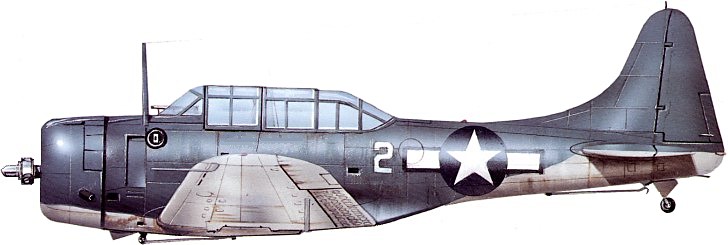
In the Guadalcanal Campaign the Dauntless - operating from US carriers and from Henderson Field on the island of Guadalcanal itself - took a huge toll of Japanese shipping. SBDs sank the carrier Ryujo in the battle of the Eastern Solomons, and damaged three other carriers in the battles of Eastern Solomons and Santa Cruz. In the decisive Naval Battle of Guadalcanal, 12-15 November 1942, SBDs sank the heavy cruiser Kinugasa and, supported by TBD Avengers, sank nine transports.
The Dauntless was older and slower than its Japanese opposite number, the Aichi D3A2 "Val" - but the SBD was far more resistant to battle damage, and its flying qualities perfectly suited it to its role. In particular - as its pilots testified - it was very steady in a dive.
When the more modern and powerfully-engined Helldiver went into action alongside the SBD it was soon realised - particularly at the Battle of the Philippine Sea - that the new aircraft was inferior to the Dauntless. But the Helldiver was already in large-scale production and it was too late to reverse the decision that it should supplant the Dauntless in shipboard service. The SBD was gradually phased out during 1944, and the 20 June 1944 strike against the Japanese Mobile Fleet in the Battle of the Philippine Sea was therefore its last major action as a carrier-borne aircraft. The SBD nonetheless continued to be used effectively by the Marine Corps right up to the end of hostilities in August 1945, most notably in the Philippines campaign.

Type: Two-seat carrier-based and land-based dive-bomber
Dimensions: Length 33' 0"; span 41' 6"; height 12' 11"
Weight (typical): Empty 6,535 lb, loaded 9519-10,700
Engine: One 1,000 hp
Wright (R-1820-32 or R-1820-52)
![]() or 1,200
hp (R-1820-60 or R-1820-66) Cyclone 9-cylinder radial
or 1,200
hp (R-1820-60 or R-1820-66) Cyclone 9-cylinder radial
Performance (SBD-5): Maximum speed 252 mph, initial climb 1,500 feet per minute, service ceiling 24,300 feet
Range: As dive-bomber 456 miles - as scout-bomber 773 miles
Armament (later versions) -
![]()
One 1000lb or 500lb bomb under fuselage
Two 250lb or 100 lb bombs under wings
Two fixed forward-firing 0.5-inch Browning machine-guns
in nose
Twin manually-aimed 0.3-inch Browning machine-guns in rear cockpit
![]()
Pacific
Aircraft - Index
![]() Douglas
SBD Dauntless - by Peter C. Smith
Douglas
SBD Dauntless - by Peter C. Smith![]()
![]() Grumman
TBF Avenger - shipborne torpedo-bomber
Grumman
TBF Avenger - shipborne torpedo-bomber![]()
F4F/FM Wildcat - shipborne fighter
Grumman F6F Hellcat - shipborne fighter
Task Force 58 - the Fast Carrier Task Force
The Battle of the Philippine Sea, 19-20 June 1944
The
Battle for Leyte Gulf, 23-26 October 1944
![]()

![]()